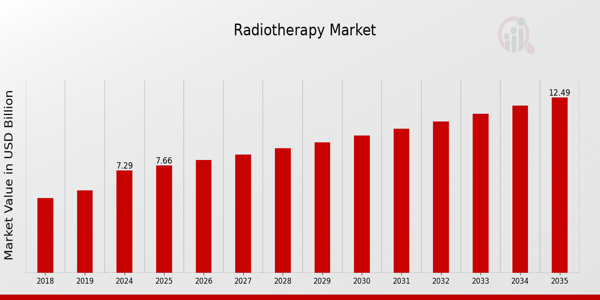Genres:Artbook
🇬🇧English
< 30 votes
0 votes
5
00.0%4
00.0%3
00.0%2
00.0%1
00.0%The radiotherapy market has emerged as a critical component of the global oncology landscape, driven by a surge in cancer cases and advancements in medical technology. Radiotherapy, which uses high-energy radiation to destroy cancer cells, is being adopted widely as a primary, adjuvant, or palliative treatment option. It offers targeted action with minimal damage to surrounding healthy tissues, making it an essential tool in modern cancer care.
Market Drivers and Demand Outlook
A significant factor propelling the radiotherapy market is the rising incidence of cancer globally. According to international cancer research organizations, millions of new cases are diagnosed each year, with breast, lung, prostate, and colorectal cancers being the most prevalent. This increasing patient pool fuels the demand for effective and minimally invasive treatment options like radiotherapy.
Technological advancements are also shaping the growth of this market. The introduction of image-guided radiotherapy (IGRT), stereotactic body radiotherapy (SBRT), and intensity-modulated radiotherapy (IMRT) has improved precision and outcomes. Modern machines can deliver higher radiation doses more accurately, reducing treatment time and improving patient recovery rates. This tech-driven evolution has significantly enhanced clinician and patient confidence in radiotherapy.
Expanding Infrastructure and Regional Growth
Healthcare infrastructure improvements, particularly in emerging economies, are expanding access to radiotherapy. Countries in Asia-Pacific, Latin America, and parts of Africa are investing in oncology centers and modernizing existing facilities. Government and private funding initiatives are further accelerating the procurement of advanced radiotherapy systems.
North America continues to dominate the market, thanks to a robust healthcare system, early technology adoption, and favorable reimbursement policies. Europe follows closely, with widespread awareness and government-supported cancer care programs. However, the Asia-Pacific region is witnessing the fastest growth, driven by rising cancer awareness, increasing healthcare expenditure, and growing partnerships with global medical device companies.
Challenges and Constraints
Despite the positive outlook, the radiotherapy market faces challenges. The high cost of radiotherapy equipment and infrastructure often limits access, especially in low- and middle-income countries. Additionally, a shortage of skilled professionals trained to operate advanced radiotherapy systems can hinder the adoption and effectiveness of treatment.
Stringent regulatory frameworks and lengthy approval processes for new technologies also pose obstacles to rapid market expansion. However, ongoing efforts by industry stakeholders to streamline regulatory pathways and provide training programs may gradually ease these constraints.
Future Outlook and Innovation Focus
Looking ahead, the radiotherapy market is expected to evolve with the integration of artificial intelligence (AI), machine learning, and big data analytics. These tools are expected to optimize treatment planning, improve accuracy, and predict patient outcomes more effectively. Moreover, personalized cancer therapies and combined modality treatments involving immunotherapy or chemotherapy are gaining traction.
The global focus on early diagnosis and precision medicine is likely to elevate the role of radiotherapy in future oncology protocols. With continued innovation and collaboration between healthcare providers, researchers, and device manufacturers, the radiotherapy market is poised for sustained growth.
Views
Total: 0/360 days: 0/180 days: 0/90 days: 0/30 days: 0/7 days: 0/24 hours: 0/12 hours: 0/6 hours: 0/60 minutes: 0
MPark Page Creation
U.1283332 at GMT
Chapters
Reviews(0)
Comments(0/0)
MPLists(0)
